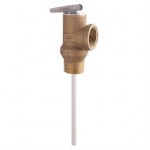This seems to be a good time to mention the following from a plumbing information site, although the risk is slight it bears mentioning:
In your home there is a rocket.

It weighs between 300 – 1200 Lbs. and can, without even a moment’s notice launch itself through the
roof of your home, fly several hundred feet in the air, and land a block away. This rocket hides in
basements, closets, garages, attics, and even under kitchen counters. However, there is a simple test you should do at least once a year that can assure the rocket will never launch. The rocket is your
water heater and you need to test the
T&P Valve at least once a year to make sure it is working properly.
There are many times when the potable water system in a home can become a “Closed System” meaning water can only flow into the home and not out. This is a desirable thing as it can guard against contaminants entering the water supply in a backflow situation. Whether it is a
check valve in the meter or, elsewhere, or, a
pressure reducing valve without a bypass your system can become a closed system. When a system is closed dangerous pressures can build in the system when the water
heater reheats due to
thermal expansion or, a malfunctioning water heater that heats the water too hot. The maximum working pressure in a water heater is 150 PSI this is established by testing and design. In all reality the actual burst pressure is much higher as the working pressure is a derated safe figure and the burst pressure is probably in the 300 PSI range.

The T&P valve has 2 functions. “T” is for temperature, and “P” is for pressure. The pressure setting of the valve is usually 150 PSI and the temperature is 210 Degrees F. The pressure exceeding 150 PSI will cause the valve to open releasing the excess pressure maintaining a safe pressure below the 150 PSI working pressure. If the temperature exceeds 210 Degrees F the danger is far greater because the high pressure in the system will prevent the water from turning to steam so you can have an entire water heater full of water hot enough to convert to steam but not converting due to the system pressure. When the temperature exceeds 210 Degrees F the valve will open and flow water until the temperature drops. If the water heater were to burst when the water is overheated above boiling, the entire contents of the water heater will instantly convert to steam. This steam will expand 1,600 times its original volume of water. This is when the launch occurs.
The T&P Valve is a relatively inexpensive device that is threaded into either the top of the water heater or, the side of the water heater near the top. There should be a tube connected to the valve which may run down towards the floor under the older codes or, under new codes it may run to a place where it can drain without causing water damage. This tube must be allowed to drain dry by gravity. If water was not able to drain out dry the metal parts could corrode and cause the valve to fail. The water in the pipe could also freeze in colder climates causing an ice plug to form in the pipe. This pipe must never be plugged or the T&P valve will become ineffective greatly increasing the danger level.
The test is simple. On the T&P Valve there is a small handle that lifts a pin in the center of the valve. Before testing make sure you are in a safe position where you will not be struck by the hot water discharge, and that you know how to shut off the water supply to the water heater. You don’t have to turn it off but you need to know how to do it as the valve when tested may not reseat properly causing water to leak. If this occurs you will need to be able to shut off the water until the valve can be replaced. All you need to do for the test is lift the handle so the valve opens then release it so it closes. If the valve is frozen so it does not open or, does not close it should be replaced ASAP. Sometimes the valve may not set properly after testing. Try opening it and allowing it to slam shut several times. If this works the valve is okay. If it doesn’t it should be replaced. This test does not ruin a valve. If the valve fails the test it was already bad and was not offering the protection you need. Regular testing may actually increase the life of the valve. Test the valve a minimum of once a year.:wsmile:

